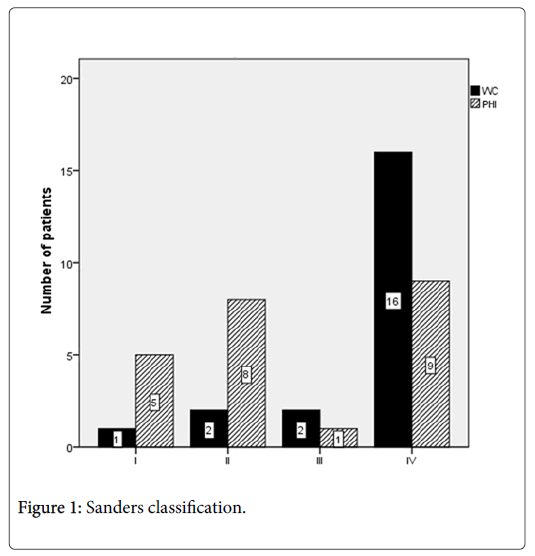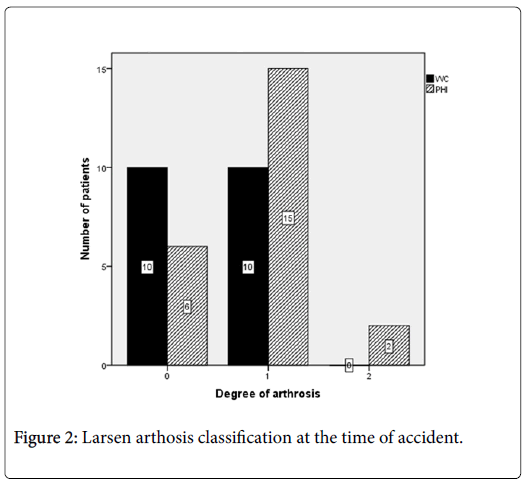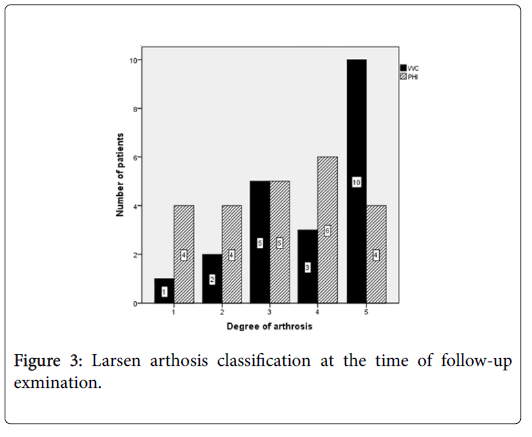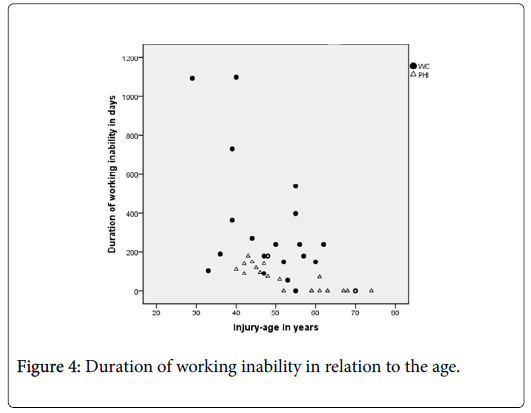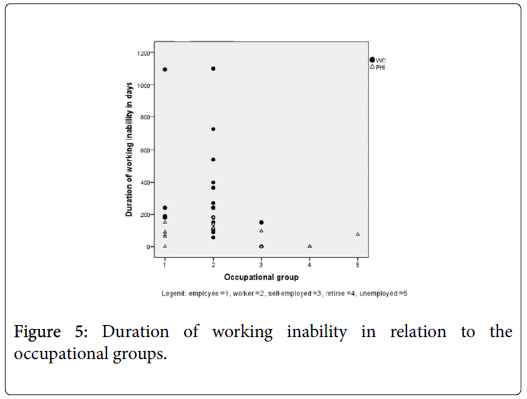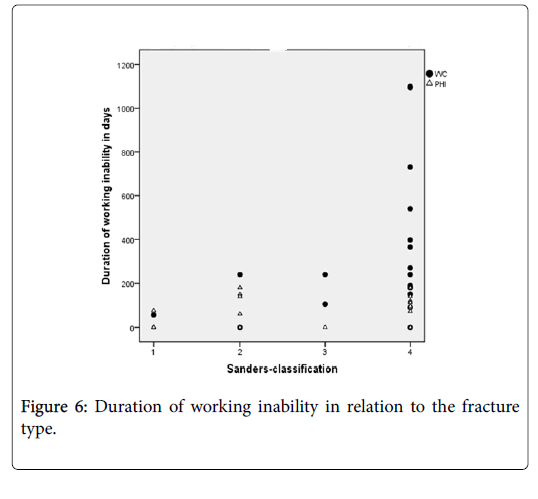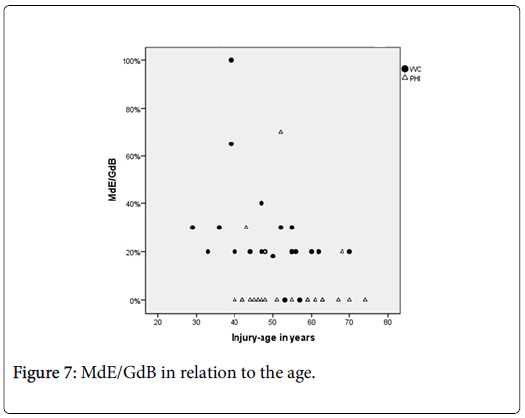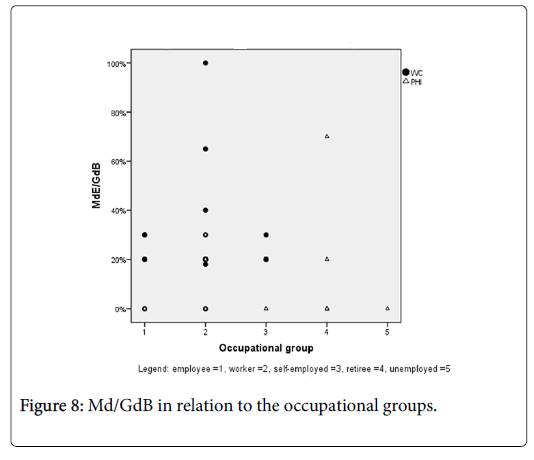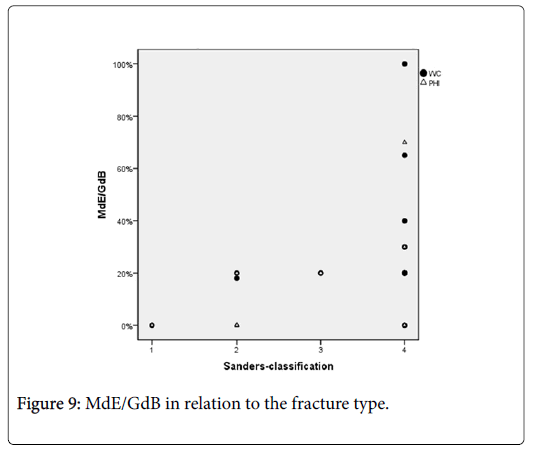Research Article Open Access
Long-Term Economical Effects of Isolated Calcaneus Fracture Depending onInsurance Status, Age, Occupation and Fracture Type
Soren Peters1, Jan Persson1, Padhraig O´Loughlin2, Christian Krettek1 and Ralph Gaulke1*1Department of Traumatology, Hannover Medical School, Carl-Neuberg-Str.1, 30625 Hannover, Germany
2Department of Orthopedic Surgery, Hospital of Special Surgery, New York, USA
- *Corresponding Author:
- Ralph Gaulke
Section Upper Extremity
Foot and Rheumatology Surgery
Department of Traumatology
Hannover Medical School
Carl- Neuberg-Str.1
30625 Hannover, Germany
Tel: 0049-511 532 2026
E-mail: gaulke.ralph@mh-hannover.de
Received date: December 12, 2016; Accepted date: January 09, 2017; Published date: January 16, 2017
Citation: Peters S, Persson J, Loughlin PO, Krettek C, Gaulke R (2017) Long-Term Economical Effects of Isolated Calcaneus Fracture Depending on Insurance Status, Age, Occupation and Fracture Type. Clin Res Foot Ankle 5:225. doi: 10.4172/2329-910X.1000225
Copyright: © 2017 Peters S, et al. This is an open-access article distributed under the terms of the Creative Commons Attribution License, which permits unrestricted use, distribution, and reproduction in any medium, provided the original author and source are credited.
Visit for more related articles at Clinical Research on Foot & Ankle
Abstract
Background: The influence of insurance status on clinical outcome and function, such as the duration of time that the patient is unable to work has not yet been fully elucidated upon in the literature, as it pertains to calcaneal fractures. These injuries are typically associated with a significant economic burden for both patient and society. In a retrospective clinical and radiological case-control study of 44 patients, with an isolated calcaneus fracture, the influence of the insurance status was evaluated.
Methods: The average follow-up time period was ten years (range 4.2 to 15.0 years). Patient satisfaction was assessed using the SF-36, AOFAS-Score, ACFAS-Score, Hannover-Score and Foot Function Index. Data relating to inability to work, reduction in ability to work/degree of disability and were collected using a standardized questionnaire. Radiologic follow-up was involved evaluation of the degree of arthrosis in the subtalar joint.
Results: The scoring systems employed revealed significant differences between the work liability and public statutory insured patients in the physical component (PCS) with SF-36 (p=0.003), AOFAS (p=0.002), ACFAS (p=0.002), Hannover-Score (p=0.003), FFI (p=0.001). Additionally, the work incapacity duration (p=0.006) and the frequency of detection of a reduction in ability to work and degree of disability (p=1.8 × 10-8) was significantly different between the two cohorts, and independent of age, occupational group and fracture type.
Conclusion: Thus, it may be deduced that insurance status, does indeed exert a significant influence on clinical outcome and specifically, the magnitude of the duration of time when a patient is deemed unable to work.
Keywords
Trauma; Calcaneus fracture; Insurance status
Introduction
Approximately, 1–2% of fractures involve the calcaneus [1]. For decades, much controversy has existed as to the optimal treatment of these injuries whether it be conservative or operative. Though both approaches have their advantages and disadvantages, none lead to a true restitutio adintegrum [2].
According to statistics published by the German workers compensation (WC), the calcaneus fracture results in an inability to work (Minderung der Erwerbsfähigkeit (MdE)) more frequently than any other fracture, and incurs higher costs for treatment and long-term management [3].
Several fracture studies show that insurance status and age exert an important influence on clinical outcome and patient satisfaction [4-7]. On this specific topic, there is a paucity of data in the literature pertinent to calcaneal fractures [2,8].
The current retrospective study on isolated calcaneus fractures aims to show the influence of insurance status on function, patient satisfaction, duration of incapacity to work (Arbeitsunfähigkeit (AU)), degree of reduction in ability to work (MdE), degree of disability (Grad The current retrospective study on isolated calcaneus fractures aims to show the influence of insurance status on function, patient satisfaction, duration of incapacity to work (Arbeitsunfähigkeit (AU)), degree of reduction in ability to work (MdE), degree of disability (Grad der Behinderung (GdB)) according to age, occupation and fracture type.
Methods
In a retrospective clinical-radiological case-control study, all patients of at least 18 years of age, suffering from an isolated calcaneus fracture were analyzed. Of those 262 patients that were treated for isolated calcaneus fractures in the current authors’ trauma center from January 1995 to December 2005, 44 patients could be followed-up clinically and radiologically (Table 1).
| Patient collection | Number of patients |
|---|---|
| Study participants | 44 |
| X-rays incomplete | 2 |
| Died | 13 |
| Denied examination | 78 |
| Not available | 125 |
| Total | 262 |
Table 1: Patient collection.
Standardized questionnaires were sent to all patients, including the AOFAS-score, ACFAS-score, Hannover-score, Foot Function Index and SF-36. The circumstances of the accident, type of injury, type of therapy and insurance were gleaned from medical records. The duration of inability to work, follow-up rehabilitation, reduction of the ability to work or degree of disability, necessity of change of occupation, prescription of orthopedic aids and physical or medical therapy were established in the follow-up examination.
Using a standardized examination questionnaire, during the followup examination, the following parameters were recorded: change of gait, supporting leg, one legged standing, Romberg test, foot statics, joint mobility and stability, sensory and motoric function and circumference of the lower extremities, dysesthesia, pain, swelling, and skin changes.
All patients underwent plain radiograph with the distal lower leg imaged in two planes, axial calcaneus and lateral foot under weight bearing as recommended by the AOFAS. The radiologic follow-up allowed evaluation of tarsal axis conditions and the degree of arthrosis in the subtalar joint. The degree of arthrosis was established at the time of accident, after reduction and at follow-up examination according to Larsen et al. [9]. The fracture type was classified using the Sanders classification from X-ray and CT images taken on the day of the accident [10].
Using matched-pair analysis, the clinical results from work accidents (covered by the worker´s compensation) and private accidents (covered by the Public health insurance (PHI)) were compared. The pairs were chosen according to the appropriate assignment to a subgroup within the Sanders fracture classification.
The data were collated using Microsoft Excel 2003 and evaluated with the statistics software SPSS version 18.0. The probability calculations were performed using the Student’s t-test.
Results
The 44 patients were divided according to their insurance status into two groups: 21 patients (16 male, 5 female) suffered a working accident (cost object: German Workers Compensation - WC). Within this group, 19 patients were operated upon and two were conservatively treated. The average age of this group at the time of trauma was 48.9 (range, 29.2–69.7) years and at the time of follow-up 59.5 (range, 41.1– 79.6) years. The follow-up examination interval had been 10.6 (5.5– 15.0) years after the trauma.
Twenty-three patients (14 male, 9 female) suffered a private accident (cost object: Public health insurance - PHI). Eighteen were operated upon and five were treated conservatively. The average age of this group at the time of accident was 54.3 (39.6–73.6) years and at the time of follow-up examination 62.8 (48.6–79.2) years. The mean follow-up examination time interval was 8.5 (4.2–14.3) years.
Fracture classification
The distribution of fractures according to the Sanders-classification shows that the severity of fractures within the group of working liability insured patients is higher compared to those within the group of public health insured (Figure 1) [10].
A significant difference in the amount of patients was observed within the group of Sanders II (p=0.04) and IV (p=0.01), but not within the remaining groups Sanders I (p=0.1) and III (p=0.51).
SF-36 and foot scores
Using the SF-36 (minimum value: 0, maximum value: 100), it was observed that in the context of working accidents, the physical component (PCS-value) had a significantly lower value of 37.3 (25.5– 61.5), compared to private accidents with 46.9 (29.7–576) (p=0.003). No significant differences were observed in the psychological component (MCS-value). It was 48.4 (29.7–63.5) points in working accidents and 50.8 (28.8–63.2) points in private accidents (p=0.492).
Following working accidents, patients achieved an AOFAS-score (minimum value: 0, maximum value: 100) in average of 59.1 (33–97) points and following private accidents 75.3 (30–95) points (p=0.002). With regard to the foot function index (minimum value: 0, maximum value: 162, where lower values stand for a better outcome) patients suffered from working accidents found themselves with 75.5 (0–139) points, whereas 34.4 (0–111) points were documented in patients with private accidents (p=0.001).
The Hannover score (minimum value: 0, maximum value: 100) yielded in the group of patients with working accidents a mean value of 39.0 (20–80) and in patients with private accidents 55.8 (26–77) points (p=0.003). Module 4 (ankle joint) of the ACFAS score (minimum value: 0, maximum value: 100) found an average of 58.2 (33–82) points with working accidents and 72.0 (39–91) points for patients with private accidents (p=0.002).
Larsen-arthrosis classification
At the time of accident, the average degree of arthrosis in the lower ankle joint in patients with working accidents was 0.5 (0–1), whereas in patients with private accidents 0.8 (0–2) (p=0.058) (Figure 2). At time of follow-up examination the score in patients with working accidents increased to 3.9 (1–5) and in private accidents only to 3.1 (1– 5) (p=0.047) (Figure 3). The average deterioration over time within the group of working accidents was 3.4 (p=1.02 × 10‾10) and in the group of private accidents 2.3 (p=9.1 × 10-9). This difference was highly significant in both groups. However, the deterioration within the group of working accidents was significantly higher (p=0.005).
Duration of working inability
Within the group of WC insured patients, two self-employed patients reported no days absent from work. The remaining 19 patients reported an average working absence of 342.1 (56–1100) days. Eleven patients of those who suffered from private accidents reported no absence from work, either because they were self-employed or already retired. The remaining twelve were absent from work for a mean of 118.0 (60–180) days. Without considering those reporting no absence from work, the duration of work absence was significantly longer (p=0.006) in patients who suffered a working accident. Including the patients who had not been absent, after excluding the retired, the pvalue is still 0.007. The duration of inability to work in relation to age, occupational group, and fracture type are shown in Figure 4–6.
Reduction in ability to work (MdE)/degree of disability (GdB)
Within the group of patients with working accidents, 19 received a MdE with an average of 29.6% (range, 20–100). Among the patients who suffered a private accident, four patients received a GdB with an average of 35% (range, 20–70). The degree of MdE and GdB did not significantly differ (p=0.65), however, the frequency of detecting an MdE and GdB was highly significant (p=1.8 × 10-8).
A disability was more frequently detected in patients who suffered from a working accident, who are in the same age groups (Figure 7) and within the same occupational groups (Figure 8), than in patients with private accidents. The severity of calcaneus fractures had an influence on the degree of disability, mostly found within in the type IV according to Sanders. Patients with working accidents were more abundant among the severely injured, than the ones with private accidents (Figure 9).
Orthotics
Eleven patients, within the group of working accidents, received insoles and seven orthopedic shoes. Within the group of patients that suffered from private accidents, ten patients received insoles but none orthopedic shoes. Prescription of custom-made insoles and orthopedic shoes occurred significantly more frequent after working accidents (p=0.003), whereas it is mostly attributable to the prescription of orthopedic shoes.
Rehabilitation measurements
Following working accidents, seven patients received an inpatient-, two an outpatient- and twelve no rehabilitation. The average duration of the rehabilitation measures accounted for 46 (range, 2–180) days. After private accidents, three patients received an inpatient-, one an outpatient- and 19 no rehabilitation. The average duration was 28 (range, 21–42) days.
Frequency of rehabilitation measurements (p=0.071), as well as duration (p=0.528) did not result in significant differences between the two groups.
Occupational change
Change in occupation resulted from seven working accidents and once following a private accident (p=0.04).
Matched-pair-analysis
In the matched-pair analysis, 13 pairs had been included. The mean values of the established scores of all 13 pairs and the appropriate significance values (p-value) after dividing them according to the insurance status (WC or PHI) are presented in Table 2.
| p-values | Hann-score | ACFAS-score | AOFAS-score | FFI | PCS (SF-36) |
MCS (SF-36) |
||
|---|---|---|---|---|---|---|---|---|
| WC | 45,2 | 61,5 | 61,6 | 60,5 | 40,8 | 48,1 | ||
| PHI | 56,3 | 74 | 74,8 | 32,4 | 47,8 | 49,7 | ||
| p-value | 0,16 | 0,04* | 0,09 | 0,07 | 0,08 | 0,73 | ||
Table 2: For 13 pairs the following overview results were found.
Legend: *significant.
Though there is a trend towards better results among the patients who are insured by public health insurance, only the ACFAS-score showed any statistical significance.
Discussion
This long-term study showed that patients who suffered a working accident covered by the workers compensation, has poorer results than those who suffered from private accidents covered by public health insurance, with regard to function, patient satisfaction and the development of arthrosis, as well as inability to work and necessity for occupational change. Only the psychological component of the SF-36 shows no statistical difference amongst the two groups. The matchedpair analysis supposes that the results are only partly dependent on the severity of the fracture.
The fact that optimal medical care after working accidents is more accessible due to legal regulations than after private accidents may lead to a longer inability to work and the fact that long-term defects from working accidents may result in a pension.
In terms of patient satisfaction, Buckley et al. found in their prospective scaled study, with 309 patients and a follow-up interval of two to eight years, that independent of the type of therapy, patients covered by the working liability insurance show poorer follow-up examination results, than patients covered by public or private insurance [5]. Patients with working accidents reached an average SF-36 value of 26.3, whereas patients with private accidents reached 69.7 points (p=0.001). Tufescu and Buckley examined 169 patients with a follow-up interval of at least two years [8]. Patients after operative treatment who sustained working accidents showed a worse SF-36 value with an average 54.8 points, compared to those who suffered from private accidents with an average of 69.4 points (p=0.01). Likewise with conservative therapy the working liability insured showed an average SF-36-value of 49.0 points, which again is inferior compared to those with private accidents who had an average SF-36- value of 80.6 points (p=0.0001). The current study also revealed that patients with working accidents have significantly worse results for the physical component of the SF-36 value (p=0.003), than patients who suffered from private accidents.
On the contrary, Potter und Nunley found that using the AOFASscore in a long-term study with 73 patients and a mean follow-up interval of 12.8 (range, 5–18.5) years, that there is no significant difference between working and private accidents in respect to their follow-up results [11] Working accidents achieved 68.8 points, whereas private accidents 64.7 points (p=0.49). However, they only used the subjective component of the AOFAS-score and the number of working accidents totaled only 12 patients. In the current study we were able to detect a significantly worse value (p=0.002) for working accidents using the AOFAS-Score.
Potter and Nunley also found using the Foot Function Index that there are no significant differences between the investigated groups [11]. Patients suffered from working accidents reached 22.6 points and from private accidents 20.1 points (p=0.72). Though, the current investigators demonstrated a significantly worse value for working accidents (p=0.001) for the Foot Function Index.
The literature did not reveal any comparative values for the Hannover-score and ACFAS-score; it was found in the current patients’ that these scores were significantly lower for the working accidents, compared to private accidents.
In summary, one can say that in respect to all scores that were used, except the psychological component of the SF-36, patients with working accidents have significantly worse results compared to those suffering from private accidents.
In reference to the progression of posttraumatic arthrosis from calcaneus fractures, Therman et al. showed in their study with 83 patients, that during radiologic follow-up examination only 22.9% showed no arthritic changes in the subtalar joint, whereas the followup interval in this study had been only 65 months in average and by that way below ours [12]. Further more he identified that patients with Sanders type III and IV-injuries more commonly developed arthrosis than those with type II injuries.
Gurkan et al. showed in his study with 64 patients and a mean follow-up interval of 51 months exclusively regarding Sanders type IV fractures, that 90% of examined ankle joints showed signs of arthrosis [13]. Furthermore, he pointed out the relationship between degree of arthrosis and AOFAS-score value. Patients with higher degrees of arthrosis in average reached less AOFAS-score values. In our study we were able to detect a radiologic progression of arthrosis in 43 out of 44 patients. The current authors found a significantly higher progression in patients who suffered a working accident, than those with private accidents. However, this is probably influenced by the higher severity degree of the fractures.
Evaluating the duration of inability to work Tufescu und Buckley found that in 169 patients with a follow-up interval of at least two years, there is a longer period of working inability in patients who suffered from a working accident [8]. The mean value was 175 days after operative therapy and 268 after conservative therapy. In comparison, in patients with private accidents and operative therapy it was 134 days and 206 days after conservative therapy. Spranger et al. found an average inability to work of 260 days after working accidents, where the values lie way higher in our data [14].
In the current study, it was found that the duration of inability to work after working accidents was significantly longer (p=0.006). Considering the entire spectrum of age the patients who suffered from working accidents had been longer unable to work than those with private accidents. The period of working inability increases with the severity of fracture. According to the literature the calcaneus fracture results in about 85% of working accidents to an eligible for pension reduction in ability to work of about 25.5% [3,14-16].
In the current study, it was found that, a reduction in the ability to work was more common amongst patients who suffered from working accidents than those who suffered from private accidents (p=1.8 x 10-8). The average MdE in the current study was accounted for by 29.6% and lies only slightly higher than the value from the literature. Independent of age, occupational group and fracture type working accidents lead more commonly to a MdE than private accidents to a GdB. The degree of MdE/GdB did not show a significant difference (p=0.65).
In terms of orthotics, Howard et al. found in his study of 424 patients and a follow-up interval of two to eight years that 78% of patients with working accidents, but only 54% with private accidents required custom-made shoe insoles [17]. Thermann et al. detected in his study that about 30% of all patients claim the use of orthotics, of which about half are orthopedic shoes [12].
In the current study, patients who had a working accident received orthopedic shoes, more frequently (p=0.005).
Only Prokop et al. took rehabilitation measures after working accidents (n=42) into consideration [3]. His patients spent on average 13 weeks in an inpatient rehabilitation department, which is significantly longer than the patients in the current study.
The current authors did not detect a significant difference in duration and frequency concerning rehabilitation measures between patients with working accidents and private accidents.
In the literature, only general statements can be found about occupational change after a calcaneus fracture. Schuh and Hausel found that 68% of the patients were active in the same occupation [18]. This meets our value of working accidents. Their patient stock included 27 patients with a follow-up interval of 22 months. Prokop et al. showed in his study with 42 followed-up patients in an interval of 2.5 years that 23% of the patients re-educated and in Gurkans collective 19% of the patients changed occupation [3,13]. According to the review of Bridgman et al. a reintegration depending on the occupation is successful in 24–55% of the cases [19].
In the current study, an occupational change as a result of a calcaneus fracture, occurred more commonly (p=0.04) in patients who suffered from a working accident than those who were involved in a private accident.
The matched-pair analysis with 13 pairs showed that there was a trend of poorer follow-up results amongst patients with working accidents, though the results from the single scores are for all patients more distinct. This resulted from the matched-pair analysis using the fracture severity as the basis for pair formation and by that was eliminated as a systemic error.
The limitations of this study lie with the retrospective design and the small number of patients that could be followed-up. An explanation for the small case number lies in the rather long follow-up interval. On the other hand, the long follow-up interval of mean 10.6 years among working accidents and 8.5 years among the private accidents revealed data about the long-term course of this injury. Resulting from the inhomogeneous patient stock and the small case number only 13 pairs could be formed for matched-pair analysis.
Besides medical reasons, the insurance status has a measurable influence on the long-term clinical outcome after an isolated calcaneus fracture. This effect has not only been seen in Germany but also in populations in the USA [5,7,11] Canada [13,14] UK [2], Hong Kong [6] and Turkey [19]. The treating physicians should bear this in mind in order to plan a sensible therapy.
References
- Zwipp H, Rammelt S, Barthel S (2005)Kalkaneusfraktur. Unfallchirurg108: 737-748.
- Buckley R, Tough S, McCormack R, Pate G, Leighton R, et al. (2002) Operative compared with nonoperative treatment of displaced intra-articular calcaneal fractures: A prospective, randomized, controlled multicenter trial. J Bone Joint Surgery Am84:1733-1744.
- ProkopA, Müller S, Warnke T, Rehm KE (2007) Problem FersenbeinfrakturNachuntersuchungs-ergebnisse von 42 isoliertenFrakturen. Trauma und Berufskrankheit9:315-318.
- Antapur P, Mahomed N, Gandhi R (2011) Fractures in the elderly: When is hip replacement a necessity?.ClinIntervAging6:1-7.
- Atlas SJ, Tosteson TD, Blood EA, Skinner JS, Pransky GS, et al. (2010) The impact of workers' compensation on outcomes of surgical and nonoperative therapy for patients with a lumbar disc herniation: SPORT. Spine35:89-97.
- Harris I, Mulford J, Solomon M, van Gelder JM, Young J (2005) Association between compensation status and outcome after surgery: A meta-analysis. JAMA 293:1644-1652.
- Koljonen P, Chong C, Yip D (2009) Difference in outcome of shoulder surgery between workers' compensation and nonworkers' compensation populations. IntOrthop 33:315-320.
- Tufescu TV, Buckley R (2001) Age, gender, work capability, and worker's compensation in patients with displaced intraarticular calcaneal fractures. J Orthop Trauma 15:275-279.
- Larsen A (1995) How to apply Larsen score in evaluating radiographs of rheumatoid arthritis in long-term studies. J Rheumatol22:1974-1975.
- Sanders R, Fortin P, DiPasquale T, Walling A (1993) Operative treatment of 120 displaced intraarticular calcaneal fractures: Results using a prognostic computed tomography scan classification. ClinOrthopRelatRes290:87-95.
- Potter MQ, Nunley JA (2009) Long-term functional outcomes after operative treatment for intra-articular fractures of the calcaneus. J Bone Joint Surgery Am91:1854-1860.
- Thermann H, Hufner T, Schratt HE, Albrecht K, Tscherne H (1999)TherapieintraartikulärerFersenbeinfrakturenbeiErwachsenenEinBehandlungsalgorithmus. Unfallchirurg 102:152-66.
- Gurkan V, Dursun M, Orhun H, Sari F, Bulbul M, et al. (2011) Long-term results of conservative treatment of sanders type 4 fractures of the calcaneum: A series of 64 cases. J Bone Joint Surgery Br93:975-979.
- Spranger N, Wich M, Stengel D, Seifert J, Ekkernkamp A (2011)Frakturen des Fersenbeins: Therapie und Outcome. Trauma und Berufskrankheit 13: 43-48.
- Schofer M, Schoepp C, Rülander C, Kortmann HR (2005) Operative und konservativeBehandlung der Kalkaneusfrakturen. Trauma und Berufskrankheit7:156-161.
- Zwipp H, Rammelt S, Gavlik JM, Grass R. FersenbeinbruchBringt die OsteosyntheseVorteile?. Trauma und Berufskrankheit 2: 129-132.
- Howard JL, Buckley R, McCormack R, Pate G, Leighton R, etal. (2003) Complications following management of displaced intra-articular calcaneal fractures: A prospective randomized trial comparing open reduction internal fixation with nonoperative management. J Orthop Trauma17:241-249.
- Schuh A, Hausel M (2000) Die Schwierigkeiten in der Beurteilung von Nachunter-suchungsergebnissenbeiplattenosteosynthetischversorgterKalkaneusfrakturGibteseinenpraktikablen Score?. DerUnfallchirurg103:295-300.
- Bridgman SA, Dunn KM, McBride DJ, Richards PJ (2000) Interventions for treating calcaneal fractures. Cochrane Database SystRev 2: CD001161.
Relevant Topics
Recommended Journals
Article Tools
Article Usage
- Total views: 5754
- [From(publication date):
March-2017 - Mar 29, 2025] - Breakdown by view type
- HTML page views : 4767
- PDF downloads : 987

